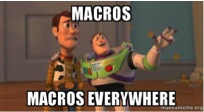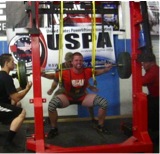I am very excited to have Jake Jensen posting to our site. Jake is a coach who I have the upmost respect for. For those of you who may not know Jake he is a coach out of Utah who recently has translated Dr. Bondarchuck’s latest book, and subtitled his lecture from The 2014 Seminar. Jake is a coach to keep on your radar because he is going to do great things in the world of athlete preparation.
Putting Supplementation In Context

I have been aware of this issue for some time, as I was once the high school kid eating foods devoid of nutrients and trying to improve my performance. I was reminded of this issue at the CVASPS Conference this year. I reflected back on it during Rick Brunner’s presentation. After reading his book, “Explosive Ergogenics” and applying some of his nutrition suggestions in my own training, I have seen great results. I want to give a little background, however, before I discuss the way I supplemented my diet, and talk a little bit about this nutrition epidemic. To put it in Rick’s words, supplementation is the pinnacle of diet in performance. Don’t start with supplements, start with a well planned diet of whole natural foods. This is great advice, from a veteran in sports performance.
NUTRITION’S DIVORCE FROM SPORT
Rick’s presentation this year talked in part about the way that the Soviet’s used nutrition as a staple for health in their sports programs. When I say sports programs, I am talking about k-12 all the way to the Olympics. Children in sport are given nutritional guidance and 
Part of the reason for this culture of healthy eating is the cost of food in Eastern Europe. Many of the processed foods in supermarkets are very expensive there, so purchasing raw foods is simply much more affordable. Take boxed cereal for example. I could buy a couple pounds of organically grown potatoes from a street vendor for about a dollar; a box of cereal cost close to four dollars. Our situation in the West is a little bit different. In the United States we are blessed to have many nutritional options available to us at low cost. We are also blessed to have relatively higher incomes with which to purchase food. Often this results in people opting for processed choices when selecting staples for their diet. Sugary breakfast cereals, bread, peanut butter, soy and almond milks, and fruit juices are all examples of what I’m talking about. Obviously I’m excluding examples of food that is simply not justifiably good for you like chips and soda. Those things go without saying. What I am trying to get at is the idea that processed food is just as good for you as the raw version. This is simply not true. For athletes who demand peak performance from their bodies, processed foods are holding them back from reaching their potential, no matter how many “advanced” supplements they take. With my clients and in my own training, supplements are added as a role player to a carefully tuned diet of real, whole, raw foods. Not the other way around.
LEARN TO SEE FOOD FOR WHAT IT IS
I absolutely believe that good nutrition is a staple in achieving peak performance. That’s not to say that God given talent and consistent (even bad) training won’t do a lot to improve performance, nutrition notwithstanding. The human body is a miraculous machine. However, if we are talking about exploiting every option for optimizing athletic
1) Macro Nutrients- It is important to see food as fuel, not as items for consumption. When my clients look at a plate of food, I want them to see it as a grouping of nutrients, more specifically as carbohydrates, protein, and fat. Take a plate of fruit with a hamburger and some potato chips, for example. What are you looking at? You’ve got some carbs in the chips and burger bun, maybe some carbs in the fruit. The burger patty gives you some protein and fat. In this way, I like to teach them to look for carbs, fats, and protein in their meals. Instead of first preference being given to taste or convenience when selecting food, selections should be made based on nutrient content. This also helps to show them that often, processed foods lack the nutritional punch that raw foods have.
2) The Watering Hole Effect- This is an interesting phenomenon I discovered while reading Robert Sapolsky’s book, “Why Zebras Don’t Get Ulcers.” On the African Savanna, wild animals will cautiously approach a watering hole, knowing that dangerous alligators live in the middle. They tend to forage around the edge of the pool and drink cautiously at the water’s edge. We can draw parallels between nature’s nutritional gauntlet and our own situation. Notice when you go to a typical big box grocery store, the layout of the merchandise. Fresh (relatively) food is sold next to the walls, in refrigerated bins. As you follow the wall around you’ll run into the butcher counter. Fresh fruit on the produce wall and a bakery on the other wall. All of the dangerous packaged, canned, refined foods are located in the middle of the store. Thus I tell my clients to “forage around the edge” of grocery stores. This helps them avoid the danger of over processed foods that are located on the aisles in the middle.
3) When Did It Die? – Sometimes I find myself thinking, “how long has it been since this potato was pulled out of the ground?” If I’m eating a box of powdered au-gratin potatoes, when were they picked? A week ago? A year ago? Five years ago? Thinking about eating five-year-old produce puts processed food in context. Preparing freshly harvested food is a much better choice for performance. Try to build your nutritional foundation around foods that have been recently harvested and grown in natures’ way. Some people will say that type of a diet is too expensive or too much work to cook. That’s just their bad excuse for being lethargic in pursuit of their lame goals. Often these are the same people who you hear throwing around absolute statements about supplements they have used. It seems like they use something new every month. This is the type of thing you want to avoid.
Once you can see food (processed or raw) for it’s nutrient content, you can begin to build a platform that will support diet supplementation. That includes getting accurate calorie counts, etc. This is critical because without the diet, the supplements won’t be nearly as effective. I wanted to give this background because I have made every mistake in the book when it comes to nutrition over the past 5 years of training. I’ve wasted hundreds of dollars on supplements and processed foods. Believe me when I say, dial in your raw food game first. You will go WAY farther doing that first. Some of my clients have gained as much as 30 pounds of muscle following these guidelines. I gave them no specific macro counts, no calorie numbers, just these guidelines. Real food jump started their performance.
MY SUPPLEMENTATION EXPERIENCE
Now that I’ve given some context to what I’m about to write, I want to talk about how I’ve 
Morning-
Creatine -5g., Fish Oil – 1g.
Pre-Workout-
Hydroxy-Methylbuterate (HMB)- 2 g., Tri-Methyl Glycine (TMG) – 1g. Beta-Alanine-5g., Caffeine.
Post Workout-
TMG- 1g., HMB- 2g., Whey- 20g., Leucine – 2g., Phosphotaditic Acid 200 mg., Magnesium Asporotates –
2g., Fish Oil- 1g.
3 Hrs. Post –
Leucine 2g., Fish Oil- 1g.
Rick’s book outlines in detail the role that each of these nutrients plays in the process of building muscle. I’m not going to delve into the details, for that you should buy the book and read it directly from the source. He also provides references to experimental studies he has tediously searched out and filtered according to his quality standards. My application of these supplements was for the purpose of getting stronger as well as bigger. I am a powerlifter, so I was also aiming for an improved performance on the platform as well as some added size. Since beginning this regimen of supplementation in April of this year I have seen the following results.
Body Weight – 232lbs. to 243 lbs. (leaner as well).
Lifts in Competition
Squat – 585lb. – 50lb. Personal Record
Bench – 400lb. – 30lb. Personal Record
Deadlift – 617lb. – 30lb. Personal Record
I can’t wait to see what this supplementation regimen will help me accomplish in the future. I hope that what you read in this article has helped you gain a more accurate perspective on how nutrition impacts performance. As a closing note, don’t settle for a canister label understanding of your supplements. Look at the resources I have listed and do your research. Don’t just take things according to manufacturer recommendations. I hate to be the one to break it to you, but they don’t care if it works. I wish you all the best in your performance pursuits. Be sure to check out my blog for more updates on nutrition and training information.
Resources:
Brunner, R. (2013). Explosive Ergogenics for Athletes. : Ultimate Athlete Concepts.
Kleiner, S. (1998). Power Eating (3 ed.). Champaign, IL: Human Kinetics.
Sapolsky, R. M. (1994). Why Zebras Don’t Get Ulcers (3 ed.). New York: St . Martin’s Press.
Henk Kraiijenhof – www.helpingthebesttogetbetter.com
Jake Jensen – www.primalteeth.blogspot.com
Nutrition and Clinical Study Information – www.examine.co
Jake Jensen is the head coach for the U of U Powerlifting Team. An undergraduate student at the University of Utah, he is studying Exercise Science and Nutrition. He works to create an optimal environment for athletes, in which they can attain the highest level of performance mother nature intended for them. Teaching great effort and dedication through discipline and enjoying the training process is what it’s all about.
We are hoping to provide the best possible content for strength coaches with each of our shows. If feel this could provide value for anyone else in the strength and conditioning field please feel free to share.
Enjoy the content? Then you should check out The Strength Coach Network!
You can find sensational content just like this in The Strength Coach Network. As a member of The Strength Coach Networks, you can access over 200 hours of the highest-level lecture content just like this one for 48 hours for only $1. Follow the link below to sign up and use the code CVASPS at check out to get a 48 hour trial for only $1. Check out The Strength Coach Network Here! https://strengthcoachnetwork.com/cvasps/
#StrengthCoach, #StrengthAndConditioningCoach, #Podcast, #LearningAtLunch, #TheSeminar, #SportsTraining, #PhysicalPreparation, #TheManual, #SportTraining, #SportPerformance, #HumanPerformance, #StrengthTraining, #SpeedTraining, #Training, #Coach, #Performance, #Sport, #HighPerformance, #VBT, #VelocityBasedTraining, #TriphasicTraining, #Plyometrics



